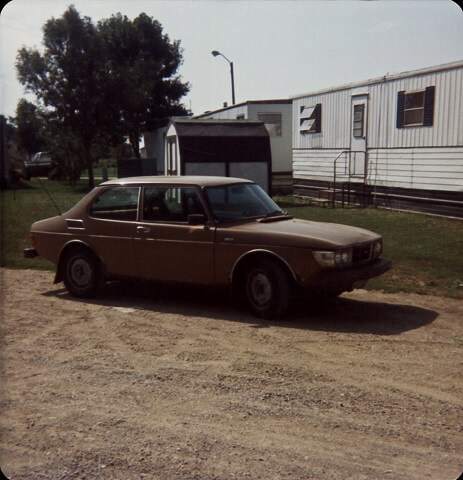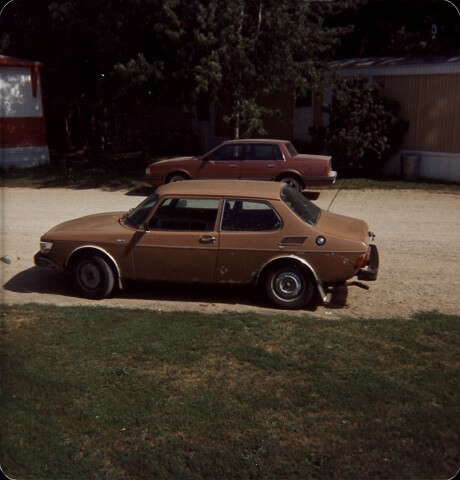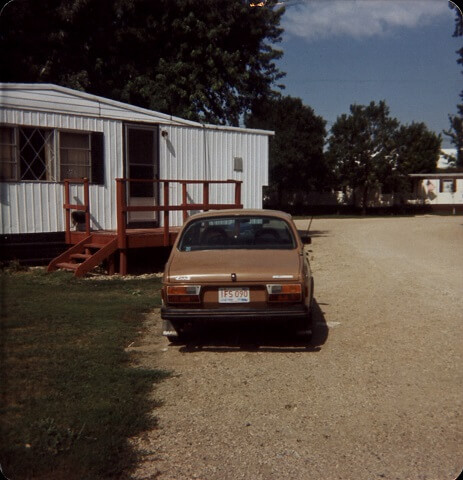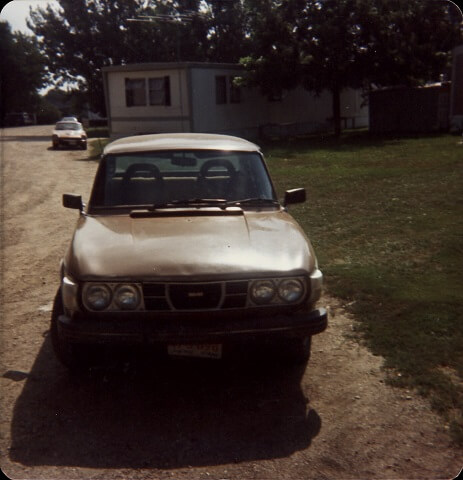My 75 Oldsmobile was failing me. The brake system was in need of some serious work (and along with that came serious money) that I just wasn't ready or able to sink into the car. Even if I had the money available, I hated the car. It had broken down and stranded me so many times I no longer was interested in keeping it around. Sometimes we as humans become emotionally attached to material possessions. In this case the opposite occurred; I was emotionally detached from the car to the point where it no longer mattered whether it could be fixed or not. I wanted out.
It was Christmas of 1988. The previous September I had started working for Hutchinson Technology Inc, a computer component manufacturing company that had opened a division in Sioux Falls. Then in November I had started working part time for DMI (Diesel Machinery Incorporated), a local heavy equipment dealer, just for some additional income. I was trying to save up money to fix up my VW Beetle which I had disassembled back in September. I would work four hours every morning at DMI, then come home and quick eat, shower and change clothes, then work eight hours at HTI. This was my Monday through Friday schedule. I would also pick up weekend shifts at HTI when they were offered.
HTI had laid everyone off for two weeks over the Christmas/New Years holidays. While I wasn't excited about the loss of income, it was kind of nice to have a two week break from one of my jobs. I traveled with my family to Independence, IA to visit my grandparents for Christmas. While I was there, I was trying to come up with a plan for a vehicle, as I knew I would have to purchase something fairly soon when I returned home.
I had saved about $1000 for my Bug rebuild project, but I knew that I would most likely have to sacrifice it to purchase running transportation. I had a couple of options. My first was to go out and purchase another car in the $300-$500 range which would leave me a little money to spend on repairs if the car would need it. My other option was to purchase a 1973 Chrysler New Yorker a friend was selling. He was asking $1000, but it was a pretty nice car and I knew the history. If I were to purchase a cheaper car out of the classifieds, I may very well end up with another lemon like my Oldsmobile. But there are no guarantees and I knew that if I purchased the Chrysler, it could easily break down unexpectedly too.
On Christmas Eve my aunt and uncle from Marion, IA came up to the house. We were talking and somehow the issue of my transportation woes came up (I think maybe my mom mentioned it.) My uncle David had four or five cars sitting around at the time. My aunt Karen had been suggesting for years that Dave would give me the '72 Porsche 914 that had been sitting in their garage for 15 years (it's still there today forty years later.) I was all for that idea, but Dave still had some sentimental attachment to that car so he was never very interested in that idea. While I would have loved it (still would) realistically at that time another derelict car project was the last thing I needed.
However, they did have an old '77 Saab 99GL sitting on the street out in front of their house. Dave said that I could buy it for $1 if it would start. I was pretty excited about that prospect. A car for $1 is hard to beat. We were planning on going down to their house in Marion on Christmas Day, so he said I could pick it up then.
That night it snowed quite a bit. I woke up a little worried that we weren't going to be able to make it to Dave's house for Christmas dinner. I was young and impetuous, so it was difficult for me to focus on anything but the car. The roads were cleared out enough and we made the drive.
At Uncle Dave's house, the car had been sitting for quite a while alongside of the street. However, it fired right up when the key was turned and true to his word, Dave signed the title over to me and wrote me a bill of sale. I handed him $1 and the car was mine.

The snow continued to fall during the day. That evening we headed back to my grandparent's house. I followed my dad in his car. Not everything was working on the Saab. When I say not everything, it would include most anything electric except for the headlights (thankfully.) However, the longer I drove it the more everything came to life. I think it had just sat long enough that the wiring needed juice running through it for a while to bring everything back from the dead.
The snow kept coming down and we were delayed in heading back home. A couple times I came up with some lame excuse for running an errand just so I could drive the car a little bit through town. The snow was so thick, though, that I didn't get to drive around too much. Nothing was open anyway. I did read the owner's manual from cover to cover.
Finally on New Year's Day we hit the road to head back to Sioux Falls. My dad had cruise control in his car, and the speedometer in the Saab wasn't working so he led the way and I followed. My brother opted to ride with me.
As we were heading up I-35 north and crossing over the Minnesota border, I looked down to see the speedometer gradually moving upwards. It continued to keep climbing and climbing, until it pegged itself at 110 mph. I knew there was no way my dad was driving that fast. After a minute it went "boing" and suddenly jerked over to read 65 mph, which was our actual speed. The speedo worked fine from that day forward.
The Saab was a quirky car. The first thing you would notice is that the ignition switch wasn't on the steering column like every other car: it was located in the center console between the seats. This seemed really weird until you think about it; when you get in the car and sit down, where is your right hand resting? It had a feature where the key would only come out if the car was in reverse (manual transmission.) Once the key was removed the car was locked in gear. However the ignition cylinder was fairly worn so the key didn't go in and out very easy. I opted to always leave the key in the ignition and carry a 2nd key on my key ring that I could use to lock and unlock the doors.
The hood opened in an unusual manner as well. When unlatched, the whole hood area including the area over the front wheels would slide forward about eight inches, and then it rotated upward to open in reverse. Apparently the idea behind this design was the hood could never fly open while the car was moving, as the air pressure would hold it shut.
The engine was a fuel injected two liter slant 4 cylinder. It was rather unusual, as it looked like someone had sliced a V8 in half. Performance was pretty decent as it was fuel injected and developed about 100 hp in a fairly light car. The car was front-wheel drive, and one would expect a transverse engine (with the engine installed perpendicular to the length of the vehicle) in order to simply the drivetrain. This car, however, used a longitudinal configuration which meant the gearbox had to transfer the rotational force of the crankshaft 90 degrees to align with the front wheels. Even more curious is that Saab was one of the pioneers of the transverse engine, but for whatever reason they didn't use it with this model car.
My particular car had a weird rattling that came from the top-end of the engine. I suspect it was a noisy timing chain, but I never did confirm this nor did I own the car long enough for it to concern me.
One curious feature was a heated driver's seat. These are commonplace in today's vehicles, but really an unusual item in a 70s era car. This was an awesome thing to have in the South Dakota winters. It automatically came on when the interior temperature dropped below 30 degrees. With all the other electrical problems the car had initially from sitting, the seat heater was the last one to rectify itself. I was unaware that the seat even had a heater installed. I was driving one cold night with some friends. The guys in the back seat were goofing around and "mooning" people in the cars behind us (which resulted in greasy bun prints left on the glass that would show up whenever the windows would fog over.) As we were driving down 41st street, suddenly my rear end started getting hot. I really thought one of the guys was screwing around and set my car seat on fire. Once I figured out the origin of the heat and that it was an intentional design, I really grew to like that feature.

At the time I disassembled my Beetle for restoration, I had a fairly nice stereo system in the Bug. This stereo was now sitting in my shed unused, waiting for the day my Bug was finished so it could be re-installed. The Saab had a plain old Blaupunkt AM/FM radio. I decided that in the interim I could install my fancy stereo in the Saab so I had something a little more enjoyable in which to listen. I spent a Saturday building an enclosure for the subwoofers, and installing everything. So now I had a $2000 stereo riding around in a $1 car. Typical teenage boy, I guess.
Along with the stereo, I had had purchased an alarm system for my Bug. That too wouldn't be needed for a while, so I decided to go ahead and put that in the Saab as well. Why not protect the expensive stereo, right? This was an early generation alarm system, which wasn't nearly as robust as the alarm systems they now produce decades later. This alarm had a pager, which would start beeping when the alarm was tripped. The pager would beep for 30 seconds before the car alarm went off. I suppose the theory was so a person could be paged with the hope of catching an intruder in the act? Not sure.
As mentioned, alarm systems have greatly evolved over time. The "brain" of this alarm had a knob used to control the sensitivity. While the knob had a long sweep from minimum to maximum, I discovered it had two basic settings: too low to be triggered even if being hit by a Boeing 747, and too high so that a bird pooping on the car would set it off.
More than once I would be awakened during the night by the pager beeping, and then rush in a panic to go out and disable the alarm before the full cacophony would start. 30 seconds was not enough to wake up, rush outside and turn off the alarm. The alarm would be sounding about the time I made it out of the house, which then would awaken the neighbors to see a kid scrambling around in his underwear trying to figure out how to get the system to shut up.
Not once did it ever sound for a legitimate reason, and after a few weeks I quickly tired of it crying wolf at all hours of the day. I uninstalled it. At least I learned that I hated it before I was to waste time putting it into my Bug.
The Saab was originally painted a tan color from the factory. This car was manufactured in the years before clear coats, and 14 years of sun had oxidized the paint to give it a chalky appearance. This effectively converted the color to what appeared to be the same hue as caucasian human flesh. It really wasn't a flattering color for a vehicle.
So I spent several days with a can of rubbing compound, carefully rubbing the layer of oxidation off the top of the paint, and then used a coat of wax to restore the shine. The results were actually quite good if I do say so myself. Well, except for all the rust spots which were still there but now had a dried white haze of Turtle Wax to make them stand out even further. All of the pictures on this page are post-rubbing compound. I wish I had taken "before" photos so the dramatic difference could be appreciated.
Unfortunately, the years of not having a protective layer of wax had taken their toll. The oxidation went deeper than what a little bit of hand rubbing would remove. After rubbing everything out the paint looked good for a couple weeks, but soon the oxidized haze would return. I re-rubbed the paint a couple times only to have the haze return. I finally admitted defeat, and let the paint return to its natural state.

During the year I owned this car, I had purchased a trailer house in Luverne, MN. Previously I had been renting an apartment for $175 a month. This apartment was really nothing more than the basement of a guy's house, but it was cheap living. Another guy who worked with me at DMI was purchasing a house, and had his old mobile home for sale. I know they're not calling them mobile homes any longer (they're now referred to as "manufactured housing") but if it has wheels under it then to me it will always be a mobile home.
Anyway, he wanted $2500 for this mobile home. I thought to myself, "Why throw money away on rent when I could apply that money to owning my own house?" I went to the bank and took out a two-year loan for $2250 at something like 18% interest which put my monthly payment at $105. The guy said he'd spot me the remaining $250 and I could pay him back over the next few months. Add $40 for lot rent and I was looking at saving money vs. renting, and in a few years I'd own my house free-and-clear!
Well, that was the plan. And it kind of worked. I did save money on my housing expenses. After about two months I paid back the $250 the previous owner had spotted me, so now it only cost me $145 per month, which was $30 less than I was paying to rent. I took in a room-mate to help share expenses as well and lower my costs (financially anyway) even further. The trailer house can be seen in the background of the photos on this page.
What I failed to completely factor in, however, was the additional expense living 25 miles outside of Sioux Falls would cost. When I moved I quit my part time job at DMI so my income dropped. However I kept working at HTI which meant I was driving 50+ miles per day. The Saab got roughly 25 mpg on the highway, and while gas was cheap at the time, I found myself burning about $15 worth a gas per week. Factoring this in meant that my overall house costs had actually risen $30 from what I was paying for the apartment. And this didn't account for the hour per day I was now spending driving back and forth between Luverne and Sioux Falls.
In retrospect, I'm sure my parents really questioned this decision. My father probably tried to talk me out of it in his own quiet way. However, they knew me well enough to realize I probably wouldn't learn the lesson until I experienced it firsthand. I did learn the lesson. I still know people who move to small towns with the idea of saving money on rent versus a comparable home in the city. I also realize that they would also learn what I did: that there are additional expenses to factor in when making a decision such as this.
Outside of gas, one of the expenses I didn't consider was the additional wear and tear on my Saab. It was an old car and while it seemed to handle the trip back and forth without too much trouble, I did rack up quite a few miles that year. I really only remember having one mechanical problem with that car, but unfortunately it was a tough one to figure out.
One night I was returning home when about a mile outside of Luverne the car sputtered and died. It acted like it was out of fuel, but the gas gauge said there was about 1/8 of a tank left. I hiked back into town, got a can of gas and then hitched a ride with my room-mate back to the car. After pouring the gallon of gas into the tank, it fired back up and I drove home.
A few days later, I was in Sioux Falls when the car did the same thing. The fuel gauge said I had an eighth of a tank remaining, but the car acted like it was out of gas. I got another gas can and put a gallon into the tank, then drove to a mechanic's shop.
When describing the problem the mechanic thought maybe it was the fuel pump. The foreign car parts market wasn't as robust as it is these days, so it wasn't unusual to have to order parts from the country of origin. The mechanic ordered a fuel pump from Sweden, and my car sat at his shop.
Meanwhile, my dad had just purchased a used car for my mom (a 1980 Buick Skylark) because her old car was reaching the end of its life. I told my dad about my dilemma, so he handed me the keys to her "new" car so I would have something to drive until mine was fixed. He said my mom could keep driving her old car for a few more days and I should drive the new one because I was on the highway so much. I had just turned 20 and at the time I wasn't mature enough to really understand the love my father had for me to do something like this. I now understand. Thanks dad. I hope you knew how much I appreciated you.
I drove my mom's Buick for a few weeks until my fuel pump finally arrived. I really didn't mind because it was the middle of July and my mom's car had air conditioning and cruise control, which the Saab didn't. Then the mechanic called me and told me that he had installed the new fuel pump but no gas was coming out. The fuel gauge read 1/8 full, but the tank was dry. So apparently the gauge was no longer accurate and that was the root of the whole problem. The mechanic put my old fuel pump back in and didn't even charge me any labor. Outside of not having my car for a few weeks, it cost me nothing. I returned the Buick to my dad and he was surprised to see I had put more than 1000 miles on it in just a couple weeks. I was driving quite a bit back and forth between Luverne and Sioux Falls.

Fall came, and I started back at college for the 2nd time after taking a year off. Things had not worked out between my room-mate and I, so I was living alone in the trailer. While I enjoyed the house, I didn't enjoy the commute. I had been talking to some mobile home courts in Sioux Falls about lots they had available with the intent to move my house out of Luverne. Moving it was going to cost between $500 and $1000, which was going to stretch my budget to say the least. $1k to move a trailer house 25+ miles seems like a bargain in today's money, but in 1989 it felt like a king's ransom to me.
With nothing else to do while living alone in Luverne, MN, I had spent a lot of time fixing up the trailer. It really was pretty decent for what I paid for it. I think it was a 1963 model, but it was 12x70 which was a good size trailer for the era in which it was built. It had solid walnut woodwork which I had recently stripped and refinished (some knucklehead had painted it with the exact same shade of brown paint.) My mom helped me decorate with some thrift shop curtains that looked pretty nice once we were done hanging them. I had done some painting and a few other repairs so it was looking good, especially on the inside.
The drive back and forth was really getting old, especially when I had 9 AM college classes. I was still working 2nd shift, which meant it was nearly midnight before I would get home. Then I would have to get up early enough to prepare and make the drive into the city.
I decided that as much as I liked the house, it wasn't in my best interest to move it to Sioux Falls. The moving cost was just too expensive and lot rent in the city was around $150 which was more than my monthly budget would allow at the time. So I reluctantly decided to sell.
However, in my research I'd done regarding moving my trailer to a lot in Sioux Falls, I had seen many trailers for sale. I knew that a comparable trailer already located in Sioux Falls would cost nearly $10,000. So rather than just trying to sell the trailer locally in Luverne, I advertised it in Sioux Falls with a "to be moved" statement. Now, the trailer didn't have to be moved and I planned to explain that to any prospective buyer, but I figured that might attract someone looking for a mobile home in Sioux Falls.
My plan actually worked. I listed the house at $4500, nearly 100% more than I had paid for the house just five months prior. The first person who came to look at it offered me $4000 cash right on the spot. She saw the same thing I did: she could purchase the house for $4000, spent another $1000 to move it and still be $5000 cheaper than the same house would have cost her in Sioux Falls. Had I had the capital to move it prior to selling it, I could have made quite a bit more money, but alas I didn't. As the old saying goes, "it takes money to make money" and I didn't have money.
I had been paying a little extra on my bank loan, and at this point I still owed $1500. I used the money from the sale to pay off the loan, which left me with $2500 in cash. I'd never had so much money in my life. It seemed like I had just gone from completely poor to incredibly rich. Again, we're talking 1989 money, so the 19 year old me felt a little like Scrooge McDuck leaping around in his vault.

I moved in with a friend in Sioux Falls who had just purchased an old house and was looking for a room-mate. Coincidentally enough my old room-mate had rented an apartment across the street from this house. The Saab carried most of my belongings back to Sioux Falls except for a few items that required the help of a friend with a truck.
On one particularly blustery winter day I opened the driver's door to the car and the wind caught it. The door flew open with quite a bit of force, and "sprung" the hinges. The door wouldn't shut. There's not a whole lot of use for a car with a door that won't shut. Not only does this expose one to the elements, it also becomes dangerous because I had to keep one hand on the handle so it wouldn't fly open around corners. I decided to rectify the situation, and managed to do so successfully by opening the door all the way and placing a jack under the end of the door. I then raised the jack high enough to lift that side of the car off the ground. With a grunt, I took a run at the door and hit it as hard as I could the same way a football linebacker would attack a ball-carrier. The door smashed shut, and I left a dent in the side the approximate size and outline of my body. The door was now jammed in the closed position which made it more practical than being stuck in the open position. The only downside was now I had to crawl in and out of the passenger door.
By this time the Saab was really showing its age, having more than 10,000 miles put on it in the previous 5 months. I had $2500 cash in my bank account, and I decided I want to use that as a down payment on a new car. I had recently been given a promotion at work which came with a small pay raise, so in November of 1989 I went to the dealership and ordered a brand new 1990 Honda CRX.
The dealership didn't want the Saab in trade. They were honest and said that they probably couldn't get more than $100 out of it and it wasn't worth their hassle. I couldn't argue. So I kept the Saab for the time being even though I had a brand new car sitting in the garage. Truth be told, the Saab didn't get driven a whole lot after I bought the CRX. At this time I removed the stereo from the Saab and installed it in my CRX.
Fast forward to February of 1990: My latest room-mate decided that his girlfriend and her kids were going to move in with him, so I had to find a new place to live. I rented a small studio apartment on the 500 block of south Minnesota Avenue. The day I was moving it was snowing. Rather than moving everything in the CRX, once again I piled the Saab full of my belongings and made the trips back and forth between my old house and the new apartment.
On my last trip back to the house, the snow was really coming down hard. The roads were getting slick and I was losing traction while trying to climb a hill. I revved up the engine trying to coax the vehicle to the top when suddenly I heard a "bang" and white smoke poured out of every nook and cranny of the dash. I really don't think I had over-revved the engine, but I apparently had stressed it to the point where something broke. I suspect I blew a head gasket. After that the engine would still run but it would quickly overheat and smoke.
The car wasn't worth a whole lot before this breakdown, but now that it couldn't even be used for transportation it really had lost value. I thought about scrapping it at a junkyard, but as luck would have it a co-worker (Dean) had the exact same year/model Saab. His was in very nice condition, with no rust. He needed some parts, particularly a new windshield and a headliner. I offered to sell him my Saab which happened to have both of those items in very good condition. Dean saw the opportunity to save himself hundreds of dollars versus purchasing those parts separately from somewhere in Sweden, so he was agreeable and we settled on a price of $60. As part of our negotiation, I had to deliver the car to his house.
I took a chance and drove it across town to where he lived out on the east edge of the city. The last several blocks were a bit iffy as the engine was overheating and sputtering, but I made it. I can't remember how I got back home, but I suspect Dean gave me a ride in his "good" Saab.
So that ended my relationship with my 77 Saab GL. As he had planned, Dean pulled the windshield and headliner and installed them in his car. He also removed a few other parts which his car either needed, or might soon need. He then sold the car as scrap to the local fire department, which proceeded to set it ablaze in order to practice rescue from a burning car. The last time I saw the Saab it was a burned out hulk sitting behind the civil defense building.
Farewell, old friend.
Return To The Main Other Gallery
This page last updated on 07/11/2018



